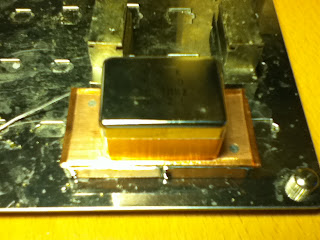Excellent! I got my feed-through capacitors on Monday and the VCO kit from Mini-Circuits. Additionally, I'll have the day off on Wednesday so there's lots of time to grab the solder iron and errr...write some reports! I just realised that I still have work to do.
Anyhow, these are super cheap Russian 100 pF feed-through capacitors. The date code on them suggests that they were manufactured in 1984. They're in excellent shape though and the one I measured was spot on. I'll use them to prevent the RF energy from escaping my prototype aluminium enclosures, since I have to get the DC power lines in there similar to how it's done in the next picture:
This is one of BG6KHC's aluminium enclosures. The leads you can see on the left side are feed-through capacitors that connect to the power lines and the serial interface of the 16-bit ADC inside. I like the ruggedness of this type of enclosure and intend to use a similar approach for my prototype modules.
For anyone who is looking at building Scotty's Spectrum Analyser and lives in Europe: the kit that contains all the necessary parts from Mini-Circuits is now available from Mini-Circuits Europe and I'd recommend you to contact one of their account managers for a quote. Their service is splendid and it took less than a week before I had the parts arrive at my office.
The kit contains:
- 1x ROS-1500+
- 2x ROS-2150VW+
- 1x TC16-161TG2+
- 4x ADE-11X+
- 10x ERA-33SM+





















































